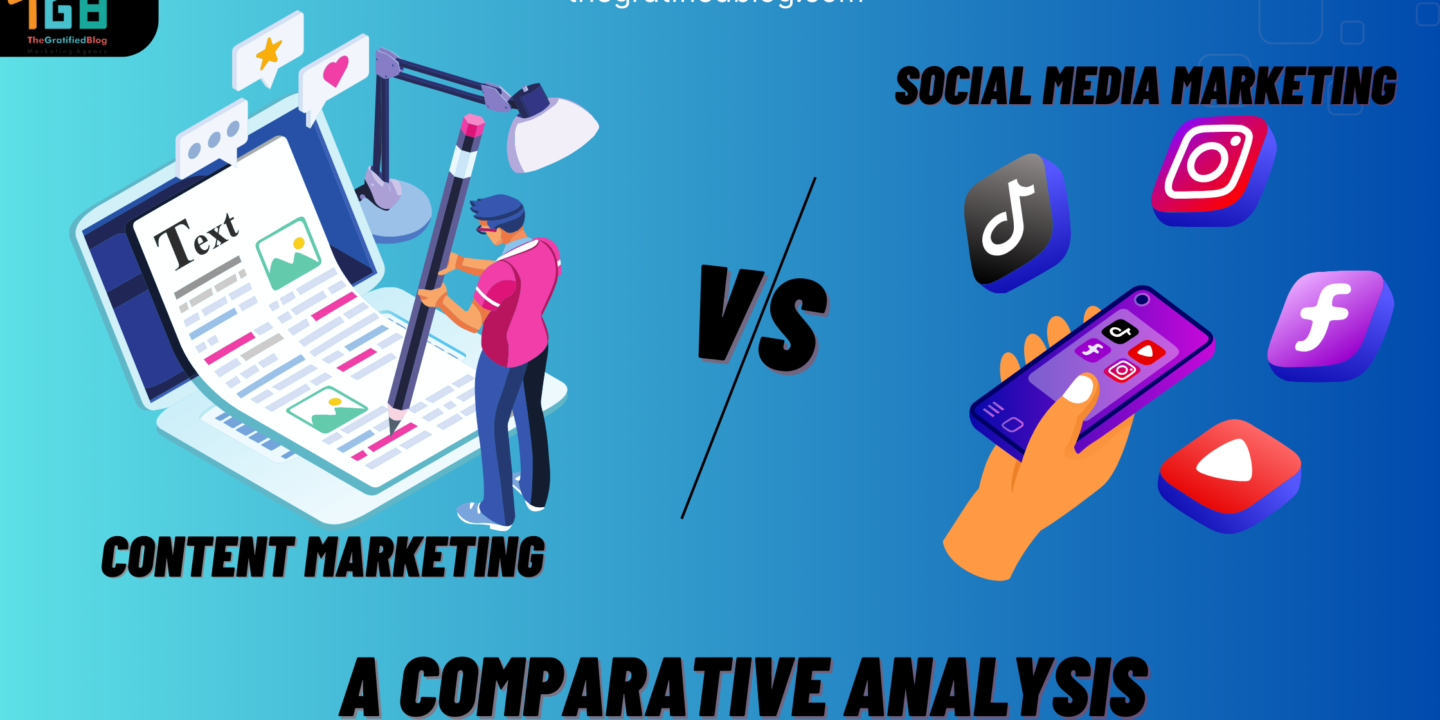
In today’s fast-paced digital landscape, Businesses are consistently seeking inventive methods to attract the attention of their target audience. Content and Social Media Marketing are popular choices and strategies that have emerged as frontrunners in this quest.
While both have their merits, they differ significantly and are better suited for different goals. In this blog, we’ll delve into the nuances of Content Marketing vs Social Media Marketing, comparing and contrasting these approaches to help you make informed decisions about which is right for your business.
What Is Content Marketing?

Content marketing is a strategic approach that generates and disseminates valuable, pertinent, and consistent content to engage and attract a target audience. It’s more about providing information and entertainment than directly promoting a product or service.
This method aims to build trust and long-term relationships with consumers, positioning a brand as an authoritative resource in its industry. Content can manifest in diverse formats, encompassing blog posts, videos, infographics, and social media updates.
By providing top-notch content that caters to the audience’s needs and interests, content marketing can enhance brand visibility, drive organic traffic, and ultimately convert prospects into loyal customers.
It is a dynamic and evolving field that adapts to changing consumer behaviors and search engine algorithms. Successful content marketing relies on understanding your audience, setting clear objectives, and consistently delivering valuable content.
What Is Social Media Marketing?

Social Media Marketing is a dynamic digital strategy that harnesses social platforms to promote products, services, or brands. It involves creating and sharing social media content on platforms like Facebook, Instagram, Twitter, and LinkedIn to engage with a target audience.
The objective is to establish brand recognition, nurture the community, and drive user interaction. This approach relies on organic content and paid advertising to reach a broader audience.
Key components include crafting compelling posts, employing visual content, and utilizing analytics to gauge performance. Social Media Marketing adapts to changing trends and consumer behavior, rendering it an essential tool for businesses seeking to enhance their online presence.
It is a direct channel for customer feedback and relationship-building, ultimately driving business growth and success in the digital age.
Content Marketing Vs Social Media Marketing
Content marketing and social media marketing constitute a pair of distinct but closely related strategies businesses utilize to reach and engage their intended audience. Here are the key differences between these two approaches:
Content Focus:
- Content Marketing: Content is the central focus here, emphasizing creating high-quality, informative, and engaging content that provides value to the audience. This approach involves crafting blog posts, articles, videos, infographics, and more to educate, entertain, or inform the target audience. The main goal of content marketing is to establish authority, build trust, and attract and retain a dedicated audience. It often involves a long-term strategy that addresses the audience’s specific pain points or interests. Unlike social media marketing, which leverages various platforms for interaction, content marketing primarily revolves around creating and distributing valuable content across different channels.
- Social Media Marketing: While content is essential, it serves as a means to drive engagement and conversations on social media platforms. In social media marketing, the primary focus is creating content that sparks interactions, shares, and comments among the target audience. It’s about leveraging the dynamic nature of platforms like Facebook, Twitter, and Instagram to foster two-way communication and build a community. Content in this context often includes posts, images, videos, and stories strategically crafted to captivate and prompt users to participate. The goal is to enhance brand visibility and establish a solid online presence through the active engagement of users on these social channels.
Goals:
- Content Marketing: Primarily focuses on building brand authority and trust and nurturing long-term customer relationships. It involves creating valuable, informative, and engaging content that educates and entertains the target audience. The main goal is to provide relevant information that addresses the audience’s needs, positioning the brand as an industry expert. Content marketing typically employs various content formats like blog posts, videos, ebooks, and more to establish authority in the field and generate organic traffic to the website. In contrast, social media marketing centers around leveraging social platforms to enhance brand visibility, interact with the audience in real-time, and promote products or services through paid ads and sponsored content.
- Social Media Marketing: Focuses on increasing brand visibility, generating leads, and engaging with the audience in real time. It primarily leverages social media platforms to build a brand’s online presence, drive website traffic, and create direct interactions with followers. The key objectives include fostering a community, promoting products or services, and enhancing customer relationships through timely responses. Likes, shares, comments, and click-through rates often measure the success of social media marketing. In contrast to content marketing, it relies on the ever-changing and dynamic nature of social media channels to deliver immediate, short-term results.
Audience Engagement:
- Content Marketing: Engagement often happens on the website or blog through comments, shares, and discussions. It revolves around creating valuable and informative crafting and Crafting content that aligns with the target audience’s tastes and preferences, prompting them to engage with the material directly. Content marketing emphasizes long-form content like articles, videos, and infographics, fostering in-depth engagement and establishing authority within a specific niche. The goal is to provide educational and entertaining content that keeps users on the website, building a loyal and informed audience. It often requires a more extended timeframe to see significant results but can yield lasting customer relationships and trust.
- Social Media Marketing: Engagement occurs directly on social media platforms through likes, comments, shares, and direct messages. It leverages the interactive nature of social networks to foster real-time conversations with the audience. Social media campaigns aim to create a community where followers actively participate and interact with the content. It’s a two-way communication channel that allows businesses to receive immediate feedback, build relationships, and gauge sentiment. By focusing on the immediacy and interactivity of social platforms, brands can adapt their messaging in response to audience preferences and trends, creating a dynamic and engaging online presence.
Ownership and Control:
- Content Marketing: Brands entirely control their content, website, and customer experience. They can curate and craft their brand message, tone, and storytelling without significant constraints imposed by external platforms. This control extends to their website’s design, layout, and user interface, allowing them to create a tailored environment for their audience. Furthermore, brands own their content, providing a solid foundation for long-term asset development and reuse. In contrast to social media marketing, content marketing is less susceptible to sudden algorithm changes or platform-specific limitations, offering more stability in maintaining a consistent brand presence.
- Social Media Marketing: Brands are subject to the rules and algorithms of their social media platforms. These platforms, such as Facebook, Instagram, and Twitter, control content visibility and reach. Brands must adhere to the platform’s terms of service and are at the mercy of algorithm changes, which can significantly impact the performance of their content. This lack of control can make maintaining a consistent and predictable marketing strategy challenging. In contrast, content marketing allows brands more autonomy in creating and distributing content on their terms, giving them greater control over their brand messaging and audience engagement.
Longevity:
- Content Marketing: Content can have a longer shelf life, continuing to generate value over time as long as it remains relevant. Quality blog posts, articles, or videos can continue to attract and engage audiences for months or even years after their initial publication. This longevity allows for sustained organic traffic and provides opportunities for evergreen content that consistently delivers results. Social Media Marketing, on the other hand, typically relies on real-time updates and short-lived posts, which may quickly fade from users’ feeds, making it less enduring compared to the timeless nature of well-crafted content in content marketing.
- Social Media Marketing: Content posted on social media platforms typically has a brief lifespan and necessitates more frequent updates to stay relevant. Social media posts may quickly get buried in users’ feeds, leading to a relatively transient impact. The fast-paced nature of social media demands constant engagement and fresh content to maintain visibility. While it provides real-time interaction, the fleeting nature of social media can make content less enduring compared to the more timeless and evergreen quality often associated with content marketing strategies. Therefore, businesses must strike a balance between the two to achieve a comprehensive and practical digital marketing approach.
Conversion Process:
- Content Marketing: Typically, content leads to conversion through a more extended and educational process. In content marketing, the emphasis is on producing valuable, informative, and engaging while addressing the needs and preferences. Challenges of the target audience. This content frequently manifests in the shape of blog posts, ebooks, videos, or whitepapers, and it aims to establish authority and build trust with the audience over time. The conversion process in content marketing is gradual, as it involves nurturing leads and guiding them through the sales funnel by furnishing pertinent and valuable information at each stage. Ultimately, content marketing fosters long-term customer relationships based on trust and expertise.
- Social Media Marketing: Conversion is often more direct, with users encouraged to purchase or sign up immediately. Companies can use social media platforms as a direct conduit for
- interacting with their audience and prompt quick conversions through compelling calls-to-action (CTAs). The focus is driving immediate, measurable results, such as click-through rates and sales. Social media marketing leverages the viral nature of these platforms to rapidly spread messages and promotions, fostering real-time interaction and transactions. It’s a powerful tool for boosting short-term sales and brand engagement.
Choosing The Right Strategy
The appropriate strategy depends on your business objectives, target audience, and available resources. Here’s when to use each approach:
Use Content Marketing:
- If your goal is to establish authority in your industry.
- When you want to build long-term customer relationships.
- If your target audience prefers in-depth, educational content.
- For sectors where regulatory constraints limit social media activities.
Use Social Media Marketing:
- When you need to increase brand visibility quickly.
- If you want to engage with your audience in real-time.
- For businesses catering to younger demographics who are more active on social platforms.
- To promote flash sales, events, or time-sensitive offers.
FAQ’S
Q1. Which Is Better, Content Marketing Or Digital Marketing?
Ans: Content and digital marketing are not directly comparable, as they serve different purposes. Content marketing involves creating and sharing valuable content to engage and educate your audience.
Digital marketing covers a broader spectrum of online tactics involving SEO, social media marketing, email marketing, and other strategies. The effectiveness of either method depends on your specific goals and target audience.
A successful digital marketing strategy often includes content marketing as a critical component to attract and retain customers.
Q2. Is Content Marketing The Same As SEO?
Ans: Content marketing and SEO are closely related but different. Content marketing centers on crafting valuable and pertinent content to engage and educate your audience. A
t the same time, SEO (Search Engine Optimization) is a specific strategy to optimize your Developing content to attain a superior position in search engine rankings. Content marketing can include SEO as part of its strategy, but SEO alone does not encompass all aspects of content marketing.
Effective content marketing often includes high-quality, optimized content to enhance visibility and attract organic traffic from search engines.
Conclusion
Content and Social Media Marketing play essential roles in the digital marketing landscape. They complement each other, and the choice between them should be based on your specific business goals, target audience, and resources.
Content Marketing is ideal for nurturing long-term relationships and establishing authority, while Social Media Marketing effectively increases visibility and engages with your audience in real-time.
In numerous instances, a well-rounded approach that integrates aspects of both strategies, recognizing the difference between Combining content marketing and social media marketing, can be the most effective in attaining your marketing objectives.
Also read: Content Marketing vs. Digital Marketing, and
Content Marketing Vs. Inbound Marketing








No Comments